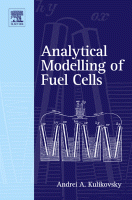Browse content
Table of contents
Actions for selected chapters
- Full text access
- Book chapterAbstract only
Chapter 1 - Fuel cell basics
Pages 1-38 - Book chapterAbstract only
Chapter 2 - Catalyst layer performance
Pages 39-82 - Book chapterAbstract only
Chapter 3 - One-dimensional model of a fuel cell
Pages 83-115 - Book chapterAbstract only
Chapter 4 - Quasi-2D model of a fuel cell
Pages 117-192 - Book chapterAbstract only
Chapter 5 - Modelling of fuel cell stacks
Pages 193-272 - Book chapterNo access
Bibliography
Pages 273-281 - Book chapterNo access
Abbreviations
Page 283 - Book chapterNo access
Nomenclature
Pages 285-291 - Book chapterNo access
Index
Pages 293-295
About the book
Description
In fuel cell research, the gap between fundamental electrochemical processes and the engineering of fuel cell systems is bridged by the physical modelling of fuel cells. This relatively new discipline aims to understand the basic transport and kinetic phenomena in a real cell and stack environment, paving the way for improved design and performance. The author brings his unique approach to the analytical modeling of fuel cells to this essential reference for energy technologists.
In fuel cell research, the gap between fundamental electrochemical processes and the engineering of fuel cell systems is bridged by the physical modelling of fuel cells. This relatively new discipline aims to understand the basic transport and kinetic phenomena in a real cell and stack environment, paving the way for improved design and performance. The author brings his unique approach to the analytical modeling of fuel cells to this essential reference for energy technologists.
Key Features
- Covers recent advances and analytical solutions to a range of problems faced by energy technologists, from catalyst layer performance to thermal stability
- Provides detailed graphs, charts and other tools (glossary, index) to maximize R&D output while minimizing costs and time spent on dead-end research
- Presents Kulikovsky’s signature approach (and the data to support it)—which uses "simplified" models based on idealized systems, basic geometries, and minimal assumptions—enabling qualitative understanding of the causes and effects of phenomena
- Covers recent advances and analytical solutions to a range of problems faced by energy technologists, from catalyst layer performance to thermal stability
- Provides detailed graphs, charts and other tools (glossary, index) to maximize R&D output while minimizing costs and time spent on dead-end research
- Presents Kulikovsky’s signature approach (and the data to support it)—which uses "simplified" models based on idealized systems, basic geometries, and minimal assumptions—enabling qualitative understanding of the causes and effects of phenomena
Details
ISBN
978-0-444-53560-3
Language
English
Published
2010
Copyright
Copyright © 2010 Elsevier B.V. All rights reserved
Imprint
Elsevier
